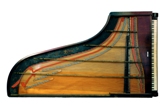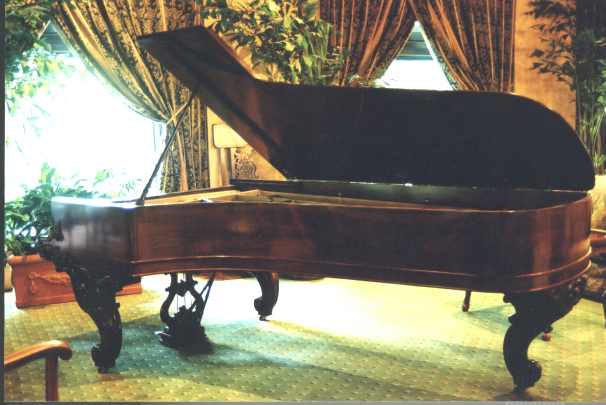|
INTRODUCTION
This is the second edition of this site. It is now organized into a set of sub-pages. We invite the suggestions of knowledgable piano experts, piano builders, preservers and restorers; piano designers; piano manufacturers, piano historians, archivists and curators, and piano technicians.
The Early Steinway Research Project
This project is a “history of technology” study of the early Steinway piano from 1853 to 1892.
This project includes several inter-related components:
1. Archival research: Development of a database from the Steinway log books; extensive study of other early Steinway documents and correspondence.
2. Identification and documention of early Steinway pianos through site visits and the gathering of photo and technical documentation;
3. Collection of important early Steinway artifacts and pianos for archiving. teaching and performance;
4. Teaching and lecturing within the Piano Technicians Guild and other venues.
5. Publication of a book on the early Steinway piano.
It is my aim to increase the public awareness of early Steinway pianos, especially among piano technicians and piano historians. I hope to correct long-held inaccuracies restraining our understanding of the early Steinway. I hope to increase understanding of the restoration and conservation issues and encourage responsible custodial care. I hope to raise the early Steinway to the respect which it once received as a musical instrument and a technologically advanced marvel. And I hope to bring attention to the little-known designs which had their own claim to brilliance.
SITE VISIT AND LECTURE
I document early Steinway pianos and lecture on the Early Steinway. I endeavor to schedule my presentations so that I can also coordinate a site visit for documentation. With your help I am thoroughly charting the development of the Steinway piano, comparing this to piano design developments outside of the Steinway company, so that I might tell the story of this influential piano in its first 39 years. So I invite calls to document early Steinways. as well as photographs of early Steinways. Piano technicians, keyboard conservators and avocational Steinway enthusiasts may help with the gathering of important technological data on Steinway pianos from this period.
TYPES OF STEINWAY PIANOS WHICH WE ARE STUDYING
All Steinway pianos built through1892 are potential candidates to be included in this study, including squares, verticals and Mangeots. We also welcome Theodor Steinweg contributions, as well as the earliest (1860s) Grotrian-Steinwegs.
While the square piano is of little interest to most pianists today, it was the predominant piano in the early period, and included many interesting technological details. Very early in the company’s history the square included duplex scaling. In 1872 a few squares were given Theodore Steinway’s unusual patent action with a balance spring. We welcome any square photodocuments, and especially those with unique elements such as these.
The last type of piano which the company began building was the vertical. From the first these were very interesting pianos, and could reflect wing grand design elements more easily than the square. We hope to receive documentation on verticals from the early period onward, through the “double-iron” to the continuous rim backs.
Ultimately, the wing grand became the focus of Steinway’s most concentrated efforts. Steinway wing grands fit into one of the following three groups.
EARLY STEINWAY WING GRANDS IN THIS STUDY
1. Concert Grands: a. All “early” concert grands from 1856 through 1883. The first “wing” grand built by Steinway was in 1856, an 8’ concert grand serial number 791. This study includes all 8’ to 8’9” concert grands built through 1883 (in 1884 the modern version of the model “D” went into production). All had 17 bass notes (unlike the modern “D” which has 20). These were given a large number of style designations, from no style number (the first) through Style 6. Only the Centennial has a capo bar (1875 and later), others have agraffes to the top. Only earliest are 85 note, the rest 88 note compass.
b. Modern “D” Concert grands from 1884 through 1892. These modern “D”s contained unusual design applications of short longeveity, and should be documented for their historical importance. This was CF Theodore’s crowning concert grand achievement prior to his death in 1889.
2. Short concert grands:
a. All early 7’1” to 7’3” grands through 1886. The earliest had 17 bass notes, all the rest had 21 bass notes, including the model “C” pianos through 1886 (all later “C”s had 20 bass notes). Variously designated Style 1 or 2, only Style 2 beginning in 1872; agraffes to top until 1878 when it was renamed the model “C” and began to use full plate with capo bar. Continuous rim incorporated in 1880. T
b. Modern “C” grands from 1886-1892. The modern 20-note bass 1886 “C” was not based on this design, but on a down-sized version of the model “D.”
3. Iron prototype, “Style 1” and “B” grands from 1869 to 1892.
a. All 6’8” grands built from 1869 to 1878. Except for the 1869 Monitor or Iron grand prototype these were first named “Style 1” (“B” and “style 2” in 1878) but also had the factory name “Monitor” grand at first. All have 20 bass notes. All have 85 notes, agraffes to top (no capo bar). First, and most completely modern design.
b. All “B” 6’8” and 6’10 1/2” grands through 1892. All have 85 notes and 20 bass notes; 88 notes began in1892.
A fourth and completely new model as designed in 1878, the “A” 6’ wing grand.
4. All “A” 6’ grands through 1892. This is the only family which has no antique ancestor, though the “A1” is often considered antique, with its 85 notes and transitional tenor bridge.
We are also interested in other Steinway or Steinway licensee pianos, including pianos built in Germany by CF Theodor Steinweg before his departure to the US in 1865, and Mangeot pianos - Steinway “licensee” pianos built in Nancy, France in the late 1860s and early 1870s.
|



